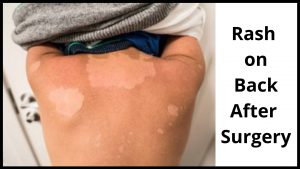
It is common to have a rash on your back after having surgery.
If you have a long recovery period and a long period of time off, you will most likely develop it again.
The reason for this is that the skin on your body heals itself but there are other factors that contribute to an already existing condition.
If you find that the rash that developed is the same rash that developed before you had your surgery, then you should check with the surgeon to see what caused it.
Most likely, it was caused by a wound that was improperly closed or sealed.
Before you can find out what causes a rash on the back after surgery, you need to be able to identify which causes of a rash on your back you have, and in some cases, you may not even know what caused it.
Rash on Back After Surgery: Causes, Diagnosis, and Treatment
One cause of a rash on the back is infection.
This is the most common cause of a rash on your back and of course the easiest to treat.
An infection of the skin will either be bacterial or viral.
The virus causes fever, a red rash, swelling, and pain.
If you get an infection of the skin, it is best to treat it as soon as possible to prevent the scarring from spreading.
Another cause of a rash on your back is fungal growth.
Sometimes when the skin around the incision is inflamed and irritated, it releases toxins that irritate the surrounding skin.
When this happens, the skin becomes moist and the fungus underneath the incision grows very easily.
There are many different types of fungi that can cause a rash on your back, but the most common one is dermatophytes.
Dermatophytes grow on any body of water, but if your doctor has recommended that you keep your back dry, then this can be a problem.
Also, materials and medications used during and after surgery can cause a rash on the back after surgery.
These medications can cause side effects on the digestive system and gastrointestinal tract.
The medications can even reverse the actions of infection and harmful bacteria in the digestive tract.
While there are mild side effects that can be expected from taking medications, there can be serious consequences if you are allergic to these medications.
When these side effects occur, they can be deadly.
Therefore, it is absolutely imperative that you inform your doctor about any medications or chemicals that you are currently taking.
Most medical practitioners will not recommend specific medications or treatments to individuals.
For this reason, you should always make a list with you and discuss with your doctor what you currently have been exposed to.
Also, ask your doctor if he has ever encountered these medications or if he can suggest a substitute that is safe.
Antibiotics are another common substance that is introduced into the body after surgery.
Unfortunately, the use of antibiotics may not be as effective as intended.
In fact, studies show that long-term antibiotic use can cause a decrease in the resistance level of the microorganisms that are believed to be behind the infection.
This can then lead to an increase in bacteria, which may become resistant to other forms of medication.
Radiation is also another common medical procedure that can cause rashes after surgery.
Also, radiation is used to eliminate the damaged tissue and eliminate any underlying sickness, but it is also powerful enough to alter the normal cells and tissues of the body.
Although radiation therapy has been used extensively to treat many medical conditions, it is also powerful enough to cause side effects on individuals.
These side effects include acne, vomiting, nausea, changes in the skin, and skin discoloration.
Before undergoing radiation therapy, you should talk to your medical professional about all the possible side effects and how they may occur.
This can also help to ensure that your wound does not become infected and that it heals properly.

WHAT TO DO FOR RELIEF.
Make sure that post-surgical instructions are followed closely.
There may be rules about physical activities, medications, and even bed rest.
Follow these directions carefully so that no further complications arise.
Even if there are no rashes or pain after surgery, it is important to rest the patient properly.
This helps prevent any unnecessary stress from the patient, which can be a cause of further problems.
1. Moisturizers.
If a rash does occur on the back after surgery, then it is important to keep the area moisturized.
Moisturizers such as creams or ointments that contain tar compounds can be used to soothe and protect the back area.
The ointment should be used in conjunction with a cream or gel that contains alpha-hydroxy acids or alpha-lipoic acid.
These ingredients are able to remove pigment and dark matter from the skin so that the area looks and feels lighter and smoother.
By using an exfoliating lotion before surgery, the patient can avoid having to deal with excess pigment and dark matter that could cause pain during the healing process.
Once the patient has been adequately rested, then she can return to work, taking short breaks and remaining more relaxed throughout the day.
This will decrease the chances that there will be additional complications or discomfort.
2. Wear loose clothing.
Wearing loose clothing is also a good idea so that extra pressure is reduced around the incision area.
This can also help to alleviate some of the swelling and pain after the surgery has been performed.
Be sure to allow plenty of time for the stitches to heal properly before being able to return to your normal activities.
There may also be some pain and swelling that remain after the procedure has been performed.
This is typically mild to moderate and will disappear over time.
In fact, most patients report that they notice their symptoms lessening within a few days of the surgery.
It is important for the patient to ensure she stores her incision site in a dry place so that the infection doesn’t have a chance to get any worse.
3. Dehydration.
Dehydration is another issue that can occur after a surgical procedure, so it is important for the patient to drink plenty of water to help replenish lost fluids.
4. Take Anti-inflammatory medications.
Taking anti-inflammatory medications that are recommended by the surgeon will also help to relieve some of the swelling and pain that is experienced after a rash on back after surgery has been performed.
Although many doctors recommend that patients refrain from exercising until their rash on back after surgery has healed, it is important for patients to continue their normal activity levels as much as possible while the rash on back goes away.
5. Avoiding lifting anything.
Keeping the patient’s affected area moisturized will also help to keep the rash from flaking or oozing and make it easier for the area to heal.
This should also include avoiding lifting anything, such as grocery bags.
If the patient chooses to resume normal activity, she should ensure that she is wearing clothing that will provide the most privacy and coverings over the area.
The patient should also avoid driving or operating machinery unless she is absolutely confident that the rash on back after surgery has gone away.
Symptoms of Rash on the Back After Surgery.
It can be very itchy and uncomfortable.
A rash on the back after surgery can often be confused with jock itch, also known as ringworm of the groin.
However, there are some symptoms of rash on the back after surgery that you should be aware of.
Jock rash usually appears as red, flaky, and dry skin around the groin area.
This is usually caused by an overproduction of the natural skin moisturizing substance called sebum.
When you have surgery, the skin is pulled taut and the edges of the skin are exposed.
If you are unfortunate enough to have jock itch, there is a good chance that the rash on the back after surgery will appear where the cut occurred.
This means that the area will become irritated and itchy.
People who have had plastic surgery are particularly at risk for developing a rash on the back after surgery.
This is because the incisions made during a procedure can often leave scars or open wounds that can be very itchy.
This is especially true for any procedure that involves the use of anesthesia.
Any type of severe wound treatment such as an infection can result in a rash on the back after surgery.
Scars from surgery also make it more difficult for your body to heal and this may mean that the rash on the back after surgery takes longer to heal than normal.
Another symptom of a rash on the back after surgery that you should be aware of is discoloration.
This means that you may have patches of pink or dark red in the area where the incision was made.
In some cases, the rash may look completely different on either side of the incision as well.
There are also chances that the rash will cover an area of the skin much larger than the one that was incised.
Rashes can appear anywhere on your body.
Don’t touch the area where the rash is located directly.
You may inadvertently pop or scratch it, causing an infection.
Also, you don’t want to risk this happening.
Rashes will go away on their own in most cases, but if they don’t you will need to treat the area and keep it clean and dry until the rash goes away.
Avoiding direct contact with the area is also recommended after you have been prescribed deodorant to avoid odor-causing rash after surgery.
If you do develop rashes, it is important that you report them immediately to the physician.
This way they can perform the treatment as soon as possible and prevent the rash from becoming worse.
Keep in mind that rashes that occur on the back after back surgery may be the sign of an infection or skin damage that needs to be addressed.
For some people, the rash will go away within a few weeks while others may need more treatment.
It’s important that you follow your doctor’s advice in order to best treat the rash.
The medical condition of the patient may also play a role in the severity of the rash.
Some people react better to treatments than others and some people may not have a rash at all.
Seek medical attention right away if you suspect that you have a rash.
Make sure that you explain the type of rash that you have and any symptoms that you may be experiencing.
Rashes that do not go away within a few days or itchiness that doesn’t subside in a day or two may indicate that there may be an infection that needs to be addressed.

Postsurgical Rashes Diagnosis – How it been done.
There are many ways that the medical community is trying to treat postsurgical rashes.
Most often, a doctor will decide which type of treatment would be best for an individual patient.
Treatments range from topical creams and ointments to oral medications and antibiotics.
Let’s take a closer look at how our postsurgical rashes diagnosed?
A doctor will use a series of tests to try to determine the cause of the rash.
These tests include things like looking at the patient’s medical history, looking at the skin around the rash, looking at eye irritation and allergic reactions, doing a physical examination, and asking questions about what medications the patient is currently taking.
Sometimes, a doctor will perform a biopsy, which is a process where a small piece of the skin is removed from the patient.
This piece of skin will be sent to a lab to be examined under a microscope to find out more information about the nature of the rash.
Sometimes, these samples are sent to a lab for a formal diagnosis.
How are postsurgical rashes diagnosed?
Once a doctor determines the cause of the rash he or she will then make the decision on the best treatment option.
Some doctors opt for an antibiotic, while others choose to look at a medication called Dermisil.
These two options have had varying success rates when it comes to curing postsurgical rashes.
Antibiotics are usually used when a person has gotten an infection or scrape and is experiencing some inflammation.
The problem with antibiotics is that they come with a list of potential side effects.
In addition to that, when you consider how long it can take for a person to recover from an infection or scrape, antibiotics can be extremely expensive.
Plus, they do nothing to rid your body of the virus that causes the infection in the first place.
Dermisil is an over-the-counter medication that is sometimes used as an alternative to antibiotics.
It does come with a long list of side effects, but because it is taken orally, it doesn’t cause the same sort of problems as antibiotics.
Because it is taken into your stomach, it passes quickly through your system.
Unlike antibiotics, which need to be introduced into the system through the mouth or the nose, Dermisil is distributed to the entire body.
This means that rashes are less likely to occur.
Also, since Dermisil lasts for a few hours, you don’t have to worry about it being effective the entire time.
Once you know how the medication is working and how the patient is recovering, it’s time to move on to asking how are postsurgical rashes diagnosed?
A doctor can only diagnose post-surgical rashes if he or she takes the proper steps to do so.
If a doctor prescribes the medication and fails to mention any recovery protocol, then it is up to the patient to follow his or her own recovery protocol.
And if instructions are given for physical therapy, physical activities, etc., the patient should do exactly as they are instructed.
How is Postsurgical Rash Been Treated?
There are two ways in which this problem can be prevented; one way is by taking the right precautions before surgery and the other way is through post-operative care.
The reason why there are two ways to prevent this problem is that it can be caused by bacteria or fungi growing on the skin or under the skin surface during surgery.
These bacteria or fungi can cause the redness, swelling, blisters, and peeling that is associated with post-surgical redness.
To treat the problem, you must first understand how this problem occurs.
Medications are often used for postsurgical rash treatment, especially antibacterial ointments and antibiotics.
These can help to reduce the bacteria in the area and soothe the pain and inflammation.
However, if the rash is severe, you may need to try more aggressive treatment methods, including steroids or surgery to stop the bleeding and promote healing.
It is always important to consult your doctor to determine the best course of treatment.
Steroids can be prescribed by your doctor to treat the rash.
This is usually done in a dosage that is not too high and will help you recover quickly.
In addition to steroids, certain antibiotics can also be given to help treat the problem.
This will depend on what caused the crash and whether it is associated with an infection or not.
If you have surgery involving stitches, it can be slightly different from how it would be for a wound that has not been injured.
The stitches will be removed and the area will be cleaned, disinfected, and potentially prepped for dressing.
This is because the infection can occur after surgery and can spread to the skin surrounding the incision.
You may have to stay away from the activity for a few weeks after the problem has been corrected, although it is possible to go back to work.
Your doctor will help you through the recovery process and will keep you informed about the progress of your healing.
The possibility of getting a blood clot in your vein is also a cause for concern.
This can occur when there is a big cut or wound in your back.
While you might feel a little pain, you are much better off taking anticoagulants such as warfarin or clotrimazole than to risk having a serious blood clot.
You will find that if the rash in your back lasts for more than a few days, it is best to contact your doctor.
However, since this rarely happens, it is not something you should worry about too much.
Knowing how is postsurgical rash being treated can help you feel better about your upcoming surgical operation.
It is important for you to know that this is a very common occurrence and almost everyone has it at some point.
Usually, the rash resolves itself after a few days, but it can take longer for it to disappear completely.
If you find that you are having a large outbreak of rashes, you should contact your doctor and see what can be done to help the situation.

Home Remedies For A Rash On The Back After Surgery.
There are many home remedies for a rash on the back after surgery that can help a person deal with this issue.
These are all tips for healing from the operation that can also be used for any other type of medical problem.
Most people who have back surgery go back to their doctor and get a prescription for a topical cream or ointment.
They are often recommended by the doctor to use this on their lower back at least two times each day for one week.
This is a topical cream that you can spray on your skin.
It comes with directions on how to use it.
If you follow them correctly, you should see an improvement in your symptoms within a week.
Usually, it takes just a few days to start seeing an improvement and you can continue to use the cream as long as you are noticing any worsening symptoms.
Before anything else, an anti-inflammatory cream should be applied to the affected area of the skin to reduce the swelling.
This will help to alleviate the rash that can be caused by the surgery as well.
There are many over-the-counter creams that are designed to work quickly and provide the patient with great results.
The most common creams used are steroidal-based.
These can be found at most drugstores and pharmacies.
Another home remedy that you might want to consider is taking a hot bath.
The hot water helps relax the muscles of your back and relieve some of the pain.
It’s a great feeling to be able to take a hot bath and relax.
Another option is to use a heating pad on your back.
This also relaxes your back and relieves some of the pain.
Keeping the patient in a warm room or shower for at least fifteen to twenty minutes after the operation can help them to be relieved of the pain and irritation as well.
Some patients even report feeling refreshed invigorated.
Adding some light exercise to the patient’s daily routine is also a good idea.
Keeping the body active can help to keep the muscles and tissues from becoming stiff and inflexible.
There are many vitamins and herbs that have been proven to help patients heal from surgery quickly.
Vitamin C and E are considered to be excellent choices for improving the overall health of the back.
Taking them regularly can help to ensure that the patient will have an easy and quick recovery.
These supplements are not a cure for the underlying problem, but they will help to alleviate the discomfort that is caused by the surgical procedure.
You might also consider apple cider vinegar.
If you have a mild infection in your lower abdomen or lower back, you might want to consider using apple cider vinegar on your skin.
This home remedy for a rash on the back after surgery will help with occasional pain and discomfort but will not cure the infection.
However, it will provide you with some relief and reduce some of your symptoms.
Use ice packs to reduce swelling and pain.
This is important after any type of surgery that involves an infection.
Keeping your muscles warm will help to speed healing.
If the infection is confined to your back area, you may only need to take baths or showers, rather than get a poultice.
Another good home remedy for rash on back after surgery is to use banana peels for relief.
The reason why the banana peels work is because they contain amino acids which help in strengthening the back.
Aside from that, they also promote circulation.
Another thing that you can do to help heal your back is to drink plenty of fluids every day.
Water helps in flushing out toxins from the body that eventually cause pain in the back.
What are the home remedies for rash on back after surgery?
These are just some of the home remedies for what are the home remedies for rash on back after surgery.
If you follow these steps, it can help to speed up the healing process.
However, if the infection does not go away on its own, it is important that you see your doctor so that he can make sure that the infection is not life-threatening.
There are some serious conditions that can be developed if your rash does not heal properly.

Why Does My Back Itch After surgery?
Your back has hairs that grow along with it in areas called the fascia.
When you’re having back surgery, you can have these hairs cut or burned off.
This causes a lot of pain for the patient because the area where the hair was growing directly behind the tissue of the back and because it’s a sensitive area, it becomes very easy to irritate the skin.
This is one of the main reasons that people ask, “Why does my back itch after surgery?”
Another cause for back itching after surgery is the general anesthesia used during the procedure.
When you have surgery of any kind, general anesthesia is used, which means it will impair your ability to feel your body and to react to what’s going on.
For some people, this means they can’t feel anything below the level of the incision.
It can also mean that you can’t feel the tenderness on your back which is a common reason for back pain after surgery.
If you have back surgery and it causes back itching, then there is no need to worry.
The reason your back feels irritated is that you’ve had the surgery and because it caused your tissues to swell in a matter of hours.
And the swelling can put pressure on the nerves can become irritated.
As long as you rest and keep the incision healed, you shouldn’t have any more problems with back itching after the surgery.
Another reason for back itching after surgery is because some of the drugs used during the surgery are not well absorbed by the body and therefore it is released into the body.
When the drugs are released into the body they can interact with other processes and they can lead to other problems.
Some of the drugs include anesthetics, antibiotics, anti-inflammatory drugs, and other medications.
It is important to find a good doctor who can recommend something that will help stop or reduce back pain.
Finding a doctor who specializes in back surgery might be the best choice.
Many people are concerned with the itching and soreness that they may experience after having surgery.
Itching is normal after any type of surgery, but if you notice that your back is itching very badly it is important to see your doctor so that he can diagnose what is wrong.
The reason that you are experiencing back pain after surgery is that your body has had some damage done to it.
After the surgery, your back may feel raw for a few days after the procedure has been performed.
This is normal and it is a good sign that your surgery was a success.
However, your back may continue to feel raw for several more weeks, and you may have some pain that continues after the healing is complete.
After the back surgery, you will most likely have some soreness in your lower back and at the same time some swelling.
Many people describe back pain and soreness as a burning sensation.
Sometimes it can feel like the muscles in your back are tightening or having a nerve cut.
At times people experience numbness and tingling in their legs or feet.
The most common reason why does my back hurts after back surgery is because of the way that the bone around the spine was repositioned.
A surgeon made an incision in your back using staples.
Your skin is then pulled taut when the staples are removed.
This pulls the bone out of your back, making a small opening for the surgeon to make a pocket for the bone to fit into.
Once the socket is created, the surgeon leaves the area alone until it heals.
As soon as the wound falls closed, your back begins to heal.
Another reason why does my back hurts after back surgery is because the muscles in my back may have been strained during the surgery.
When the muscles are strained they can cause you great pain.
This type of pain usually goes away after about a week or so.
If it lasts longer than a week you should contact your surgeon to see what they think the problem might be.

Is A Rash A Side Effect Of Anesthesia?
Many patients ask if a rash really a side effect of anesthesia?
One thing for sure is that an anesthetic rash is not common with anesthesia.
Anesthesia is used for many procedures and a patient would expect the anesthetic to give a certain amount of pain relief as well as numbing in the area being treated.
With that said an anesthetic rash does not usually occur when the anesthetic is being used.
However, it does occur in rare cases when a patient has excessive medication or if the anesthetic was used for a very long time.
An anesthetic rash can occur for any number of reasons.
If a patient was on a dose of anesthetic and some of the medicine was absorbed into the skin this would be one reason for a rash.
The skin-absorbing drugs are called antinausea agents.
Another reason could be that the anesthetic rubbed off on the patient and they started to have blisters and cracked skin.
It also can be caused by a severe reaction to an anesthetic.
This could happen if the patient had a severe allergic reaction to the anesthetic.
The anesthetic itself is not a cause of the anesthetic rash but it is reacting with the medication and with the skin.
Sometimes there is only one drug that is causing the problem and then it will clear up.
In other cases, the problem is not finding the right drug to blame.
Some drugs cause a rash but others do not.
Antihistamines are commonly prescribed for allergies and for itching.
Sometimes antibiotics are given after surgery and it is possible that they could cause the problem as well.
One thing that anesthesiologists will do to help minimize the possibility of a rash after anesthesia is to keep the area clean and dry after the procedure.
This can mean that they put on a humidifier or they suggest that the patient drinks plenty of water.
Also, this will help to keep the area dry and prevent it from becoming irritated.
It will also prevent the proteins in the anesthetic itself from sticking to the skin.
Another way to reduce the chance of an anesthetic rash is to drink plenty of liquids the day before the procedure and the night before.
Normally, a patient will not experience an anesthetic rash during the procedure.
This is a rare occurrence and usually happens because the anesthetic was mixed with some other medication.
For example, if the anesthetic was acetaminophen, it could easily cause a reaction.
However, it is not likely that this would happen unless the anesthetic was mixed with something that was harmful.
Other drugs like phenerganics are more likely to cause a reaction.
If the patient is having a reaction to an ingredient in the anesthetic, then the doctor may want to check it out and see if it is toxic.
There are many reasons why a person might have a rash after receiving anesthesia.
It all depends on the type of anesthetic that was used as well as the type of medication that was being given.
If a doctor is concerned that a patient might be allergic to an anesthetic, they should alert it to the fact.
There are new pharmaceuticals on the market that are made specifically for allergies and they can be used instead of regular anesthetics.
This is probably the best way to find out whether or not a patient is allergic to the anesthetic.

When Should I Be Worried About A Rash?
If you are dealing with a rash that seems to be coming up all over your body, you may be wondering when should I be worried about a rash.
When should I go to the doctor for a rash? When should I stop taking my medicine?
You should always check with your doctor if the rash is a symptom of an illness.
Sometimes a rash is a sign of an underlying disease that should be checked out.
Rashes that spread across your face and body could be a sign of herpes, genital warts, or something else.
It’s important to get it checked out before you start using any kind of medication or treating your rash.
When should I call the doctor about my rash?
When a rash spreads across your face and body it can become quite a serious problem.
And when you see something that seems to be growing rapidly and is starting to itch, or you are noticing a rash on your knees or elbows, you should take it to the doctor as soon as possible.
They will be able to give you advice on how to treat the rash and make sure that it doesn’t come back.
When should I stop taking my medicine?
Stopping your medication can be difficult if you have had a rash for a while.
You want to keep it under control, but you want to be careful not to cause damage to your immune system by suddenly stopping your medicine.
The longer you wait the worse it will get and the more likely it is that you will get a more serious disease.
While the rash is affecting your life, you do not want to risk developing an illness because you were waiting too long to treat your rash.
When should I visit the doctor concerning my rash?
The sooner the better when it comes to dealing with a rash.
While some people can self-medicate, others will need to see a doctor.
If your rash is severe or has become infected, you will probably need to be seen by a dermatologist or other doctor.
What can the doctor do for my rash?
The most common treatment is to medicate.
It’s important to remember that some forms of rash are not contagious and cannot be treated with over-the-counter medicines.
You will also need to see a doctor if the rash is causing you to miss work or school.
This is especially important if your rash is causing you to have a hard time breathing.
While these types of rashes will usually clear up in a few days, they are annoying and can disrupt your life.
Can I prevent this problem?
The best way to relieve a rash is with oatmeal, but you can also use Aloe Vera or Vitamin E oil.
Massage the area and use soothing ointment.
When you’re trying to decide when should I be worried about a rash, you also need to consider if the rash is itchy.
If the rash becomes itchy, you can try to rub it.
However, don’t scratch the area because this can make things worse.

How Long Should A Rash Last?
How long will a rash last?
And how long a rash lasts can vary based on many factors including the type of rash, your immune system, and your overall health.
The type of rash you get will also depend on how often it is, how it affects you, and what the underlying causes of the rash are.
Some rashes can be avoided or treated while others will not go away no matter how hard you try to treat them.
The best way to answer these questions is to get a thorough diagnosis by using a physician or a dermatologist.
If your rash is on your scalp, your dermatologist may suggest that you shave the whole scalp instead of just shaving the portion where the rash is located.
The rash is actually more contagious than the hair that is growing, so by shaving it you may be reducing the spread of germs to other parts of your body.
Be sure to choose a good razor for the job.
You want something with very few passes because you don’t want to nick the area where the rash is located.
How long a rash lasts also depends on how long it takes to heal.
Some rashes will heal in only a few days, while others can take weeks or even months before they go away.
This is largely due to the particular type of rash you have and the immune system it is fighting off.
If your rash is a severe type of rash you may need to stay at the hospital for a few days until it passes.
It is entirely possible that it could spread to another part of your body if it doesn’t go away on its own.
How long a rash lasts will also depend on how often you apply sunscreen.
A rash will not go away if you are constantly exposing yourself to the sun.
Instead, you may need to use an umbrella during the day and reapply sunscreen.
Although sunscreens do not solve the problem of blemishes, they do reduce the risk of them appearing.
How long does a rash lasts is also influenced by how big the rash is?
If your rash is very small, you can probably get it by taking no steps at all.
Small rashes should be ignored and not cause you any pain or discomfort.
However, some larger rashes can become infected and require medical attention.
Contact your doctor as soon as you suspect you have a rash so that you can get it treated quickly.
How long does a rash lasts has everything to do with how you care for your skin?
If you exfoliate your skin too often it can weaken the outer layer and make a rash worse.
On the other hand, if you don’t moisturize your skin properly it can crack, flake, and peel.
It can even become infected by the oils from your skin.
To keep your skin healthy and looking good, you have to keep these three things in mind.
CONCLUSION.
There are a lot of causes for the rash on the back that you can consult your doctor or dermatologist on and it can range from anything from an allergic reaction to a wound in your body that was infected.
However, there is no need to worry about the possibility of a rash because almost all the time people recover in just a matter of days.
The first step in treating the rash is taking antibacterial medication, and in some cases, apple cider vinegar or yogurt can also be used.
Before you treat your rash on the back, you should consult your dermatologist or doctor’s advice on the best treatment for the type of rash you have.
However, sometimes your dermatologist may advise on other treatments than the one mentioned above.
For example, if the rash on back after surgery is a result of a bacterial infection, then the patient may be given oral antibiotics.
Usually, these antibiotics will kill all the bacteria in the body, but if the problem occurs again within a few weeks, then your dermatologist might give you a second treatment using topical creams.
Usually, a dermatologist will not prescribe medicines if you have other skin problems.
The only time the medicine can be prescribed by your dermatologist or doctor’s advice on treatment is if your rash on back after surgery is a symptom of another disease.
As mentioned earlier, you should always consult your dermatologist or doctor’s advice on the best way to treat your rash on back after surgery.
You do not want to take chances with your health because it is your back that is involved.
Always remember that the rash on back after surgery can disappear if you treat it early, and you should always pay close attention to your skin.
Keep in mind that a dermatologist or doctor’s advice on treatment is just that, advice.
